The Battle of the P67 Boards - ASUS vs. Gigabyte at $190
by Ian Cutress on January 20, 2011 4:15 PM EST- Posted in
- Motherboards
- Gigabyte
- Asus
- P67
Board Features
| Gigabyte P67A-UD4 | |
| Market Segment | Performance |
| CPU Interface | LGA 1155 |
| CPU Support | i3/i5/i7 Sandy Bridge |
| Chipset | P67 |
| Base Clock Frequency | 80 MHz to 200 MHz in 0.1 MHz increments |
| DDR3 Memory Speed | 1333 MHz by default, 800-2133 MHz supported |
| Core Voltage | Auto, 0.750V to 1.700V in 0.005V intervals |
| CPU Clock Multiplier | Dependant on CPU |
| DRAM Voltage | Auto, 0.90V to 2.60V in 0.020V intervals |
| DRAM Command Rate | Auto, 1N to 3N |
| Memory Slots |
Four 240-pin DDR3 DIMM slots in dual-channel Regular unbuffered DD3 memory Up to 32GB total supported |
| Expansion Slots |
2 x PCI Express 2.0 x16 slots (PCIe 1 operates at x16 in single mode, PCIe 2 operates at x8 in single mode, or x8/x8 in dual) 3 x PCI Express 2.0 x1 slots 2 x PCI slots Supports ATI Crossfire Supports NVIDIA SLI |
| Onboard SATA/RAID |
a) 2 x SATA 6.0 Gb/s ports (white) supporting RAID 0, 1, 5 and 10 b) 4 x SATA 3.0 Gb/s ports (black) supporting RAID 0, 1, 5 and 10 c) 2 x eSATA 3.0 Gb/s ports from Marvell 88SE9128, RAID 0, 1 a) + b) are capable of cross channel RAID 0, 1, 5, 10 |
| Onboard |
4 x SATA 3 Gb/s w/ RAID 2 x SATA 6 Gb/s w/ RAID 2 x eSATA 6 Gb/s w/ RAID 1 x Front panel audio header 1 x S/PDIF Out header 3 x USB 2.0/1.1 headers 1 x USB 3.0/2.0 header via Renesas (NEC) D720200 chip 1 x Serial port header 1 x Clearing CMOS jumper |
| Onboard LAN | Gigabit Ethernet via Realtek RTL8111E |
| Onboard Audio | 7.1 channel Realtek ALC892 codec |
| Power Connectors |
24-pin EATX Power connector 8-pin EATX 12V Power connector |
| Fan Headers |
1 x CPU fan header 2 x System fan headers 1 x Power fan header |
| I/O Panel |
1 x PS/2 keyboard/mouse port 1 x Coaxial S/PDIF Out connector 1 x Optical S/PDIF Out connector 8 x USB 2.0/1.1 ports 2 x USB 3.0/2.0 ports via Renesas (NEC) D720200 chip 2 x eSATA 6Gb/s ports 1 x RJ-45 port 8-channel Audio I/O ports |
| BIOS Revision | F7 Beta |
In the Box
- I/O shield
- SLI 3-slot bridge
- 4 x right-angled SATA connectors
Compared to the ASUS P8P67 Pro, both boxes do not come with much in the way of extra peripherals. Here we get an SLI 3-slot bridge (compared to the 2-slot on the ASUS) but lose the USB 3.0 rear bracket, meaning that one will have to be obtained in order to use the USB 3.0 header on the Gigabyte board.
Software
Smart 6
Smart 6 tries to encapsulate a good portion of the myriad of software available in easy-to-use quick buttons, and is essentially identical to the X58 and P55 iterations of the software. The QuickBoot portion attempts to speed up boot times by bypassing the lengthy BIOS post, assuming there has been no physical hardware change. QuickBoost is a single screen overclocking utility, similar to the EasyTune6 front page. Recovery2 helps roll back the system to a previous set of settings without predefinition of a backup time flag, and also the TimeLock, which is almost superfluous given Windows7 has Parental Controls.
The idea behind TimeLock is similar to that on the Xbox360 parental controls – specify a certain number of hours per day (in this case, two different values for weekdays and weekends) for which the computer can be in use.
@BIOS
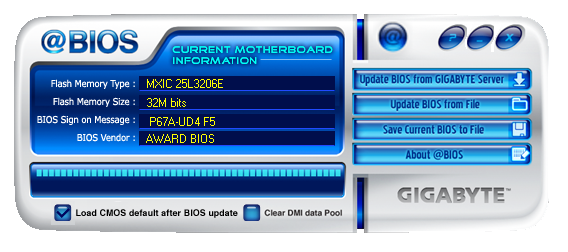
@BIOS is the staple Gigabyte BIOS update utility, and has been for a few iterations now. Users should note that to flash the latest BIOS files, the version of @BIOS on the CD is insufficient, and @BIOS 2.1 is required. 2.1 can be downloaded from the Gigabyte website.
Dynamic Energy Saver 2
Another program that Gigabyte has been using on various chipsets is the Dynamic Energy Saver 2. As you can see from the picture, various power saving features can be enabled or disabled through user settings, or you can let the software determine the best course of action.
EasyTune6
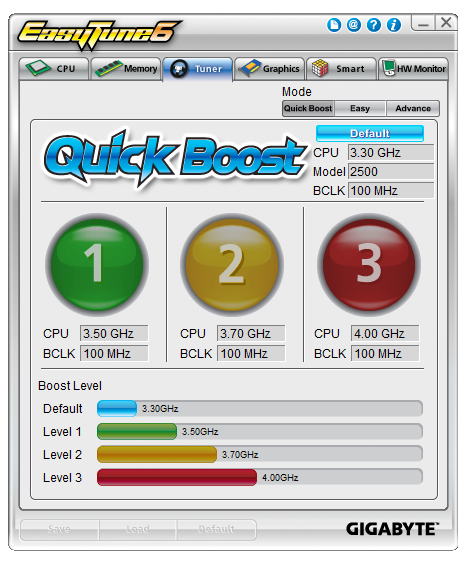
The OS overclocking tools are predominantly housed in EasyTune6. The front screen has those easy to use OC buttons, but only having three up to 4 GHz is somewhat limiting on the Sandy Bridge platform, given that most processors will happily do 4.4 GHz plus. There is no system of auto-overclocking detection similar to the ASUS boards.

Despite the software having an option for ‘real time ratio change’, of which there is an option in the BIOS to enable/disable, I could not get this to work. Upon setting a new multiplier, I was asked to reboot to apply it.
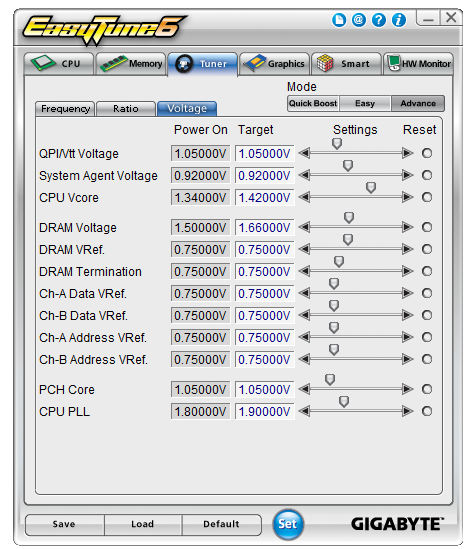
As always with EasyTune6, going to advance mode allows voltage manipulation. While it is nice to have such a wide variety of options, given that for Sandy Bridge all you really need is CPU VCore, DRAM and CPU PLL, it would have been easy just to include those in the ‘easy’ mode.

Fan control is basic in EasyTune6. Even in advanced mode, as shown above, you can choose where to put the initial and final ramp positions in terms of temperature against max RPM, but there is no option to define further points on the curve, or no determination of separate fans, so all chassis fans will be controlled by this one profile.



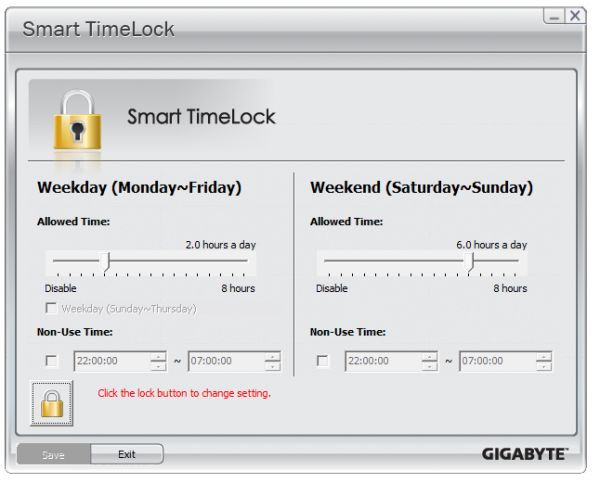
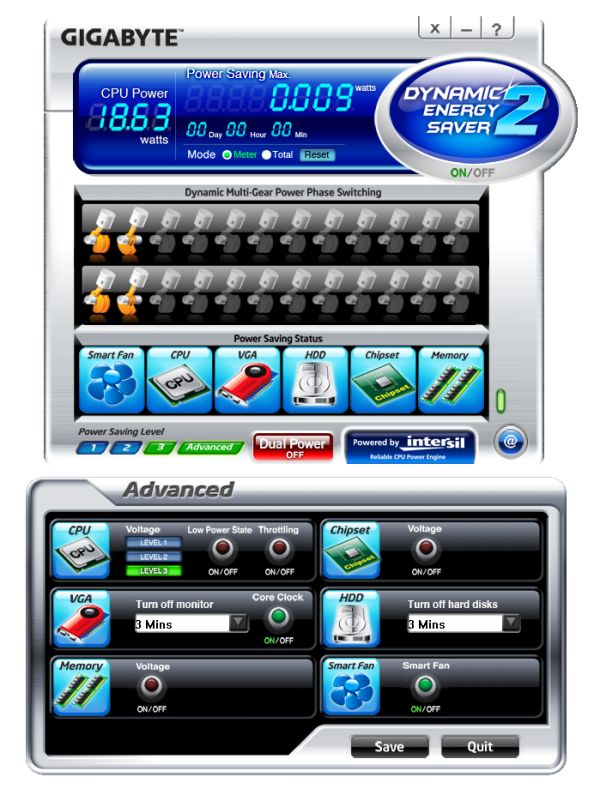








137 Comments
View All Comments
Rick83 - Friday, January 21, 2011 - link
An ASUS Xonar DX costs around 50-70$ and does the same, and remains portable to any pcie board. I chose to go with that in the end...sweetspot - Friday, January 21, 2011 - link
See this is the point exactly overlooked,""go get so and so sound card to solve your problems, but now look at the equation posted in the review ""
2x 190 mobos or the 150 mobo which is better save 40 bucks ??
See how can you save 40 bucks when they clearly did not do sound review at all, so you now need to go pay the extra 50-70 bucks for add on sound card, now you are not saving 40 bucks with the Asrock board are ya.
Sure reader can go elsewhere and do alot of extra research on the parts for that info, but the review sites are supposed to cover that whcih is the whole reason people read them in the 1st place to get info they dont have access to read and not have to go web hopping for each detail to get information, and let an expert reviewer cover that research and testing for them, the whole reason review sites exsist. leaving out details so readers have to go elsewhere for items they reviewed is not a very helpfull at all, and readers waste time reading this to find out they are SOL later on, and need to spend more time on other sites for overlooked details.
Sound is not small item or bug oversite, every mobo computer usually sound is a key part of their use for home / entertainment use types. So skipping sound and other mojor compnents in a review is terrible to the reader.
Voldenuit - Friday, January 21, 2011 - link
Blegh. Too expensive.Pass.
Concillian - Friday, January 21, 2011 - link
Agree.Seen a fair number of reviews of various $150+ P67 boards.
OCing the 2500k looks to be about as non-complex as it gets, does a mobo really make a big difference anymore aside from 20 phase VRMs or whatever for the people doing water and phase change cooling and pumping 1.5 volts through these things?
Seems like a normal person on air going for 4.4-4.6 should need nothing fancy except whatever pci-E slot config and ports they are after.
I'm waiting on a <$150 roundup somewhere.
Rick83 - Friday, January 21, 2011 - link
The worst part, is that I got a p55 UD5 for 150 euro, which has more features than the new UD5. (And cost less at launch)I don't even want to talk about the feature-decay with regard to my IP35 Pro.
It's a sad state for the mobo buyer and best to stick to the low end.
Cashano - Friday, January 21, 2011 - link
I read a lot of comments about wait for the (X/Z)(67/68) boards, problem is by then AMD is on the playing field with they new chipset and boards, but lets look at todays boards.When testing boards at $190, i would say its more fitting to test the ASRock P67 Extreme6 instead of the ASRock P67 Extreme4, seeing that its closer to the $190 mark and alot more SATA and V16 power, but thats just what I think.
Cashano.
Cashano - Friday, January 21, 2011 - link
Forgot to add, that Ext6 has 2x 1Gbit LAN, or combined 2Gbit :P new feature.Cashano
seamusmc - Friday, January 21, 2011 - link
Who really uses that feature though. I've never met anyone that takes advantage of that. Would be neat to try it.Hogan773 - Friday, January 21, 2011 - link
No - the POINT is that you compare based on what you GET and the ASRock is delivering all the features (and more) vs the $190 tier at both ASUS and GB.Maybe you're different, but when I buy something, my thought process is not "OK how much to I want to spend" but rather "what features do I want to buy" and from there, where can I get the lowest dollar price on said features.
BTW beyond the bigger power phases there doesn't seem to be that many diffs between the ASR 4 and ASR 6. Thats prob because the ASR 4 is pretty fully loaded.
Cashano - Friday, January 21, 2011 - link
You are right that there isn't a lot of difference between X4 and 6, from what i can see it is,X6 has 2x SATA3(raid), 4x SATA3(raid), 4x SATA2(raid), and V16+2 phase power, and Dual Lan.
X4 has 2x SATA3(raid), 2x SATA3(raid), 4x SATA2(raid), and V8+2 phase power, and Single Lan.
I don't know the price difference is in the US, I think its down to about $10.
Well my thought process is, what do I need here and now for cheapest price, and what do I need in 3 to 6 months, for expansion and upgrades (like crossfire and hard disk's) but that's just me.
But yes I would take the X4 over X6 if i didn't use Dual lan, or used 2 Raid setups.
Cashano